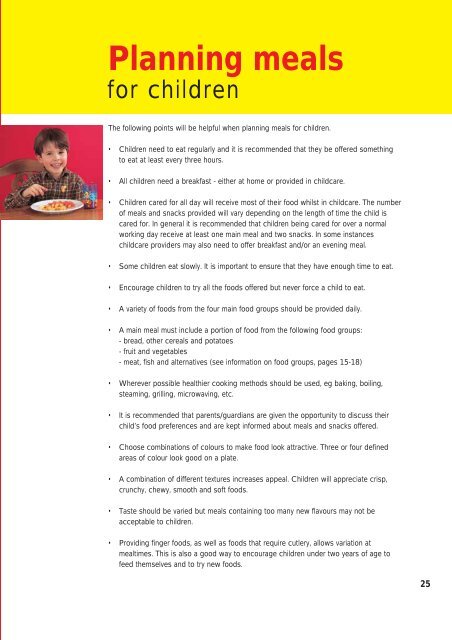Nutrition matters for the early years - Health Promotion Agency
Nutrition matters for the early years - Health Promotion Agency
Nutrition matters for the early years - Health Promotion Agency
Create successful ePaper yourself
Turn your PDF publications into a flip-book with our unique Google optimized e-Paper software.
Planning meals<br />
<strong>for</strong> children<br />
The following points will be helpful when planning meals <strong>for</strong> children.<br />
• Children need to eat regularly and it is recommended that <strong>the</strong>y be offered something<br />
to eat at least every three hours.<br />
• All children need a breakfast - ei<strong>the</strong>r at home or provided in childcare.<br />
• Children cared <strong>for</strong> all day will receive most of <strong>the</strong>ir food whilst in childcare. The number<br />
of meals and snacks provided will vary depending on <strong>the</strong> length of time <strong>the</strong> child is<br />
cared <strong>for</strong>. In general it is recommended that children being cared <strong>for</strong> over a normal<br />
working day receive at least one main meal and two snacks. In some instances<br />
childcare providers may also need to offer breakfast and/or an evening meal.<br />
• Some children eat slowly. It is important to ensure that <strong>the</strong>y have enough time to eat.<br />
• Encourage children to try all <strong>the</strong> foods offered but never <strong>for</strong>ce a child to eat.<br />
• A variety of foods from <strong>the</strong> four main food groups should be provided daily.<br />
• A main meal must include a portion of food from <strong>the</strong> following food groups:<br />
- bread, o<strong>the</strong>r cereals and potatoes<br />
- fruit and vegetables<br />
- meat, fish and alternatives (see in<strong>for</strong>mation on food groups, pages 15-18)<br />
• Wherever possible healthier cooking methods should be used, eg baking, boiling,<br />
steaming, grilling, microwaving, etc.<br />
• It is recommended that parents/guardians are given <strong>the</strong> opportunity to discuss <strong>the</strong>ir<br />
child’s food preferences and are kept in<strong>for</strong>med about meals and snacks offered.<br />
• Choose combinations of colours to make food look attractive. Three or four defined<br />
areas of colour look good on a plate.<br />
• A combination of different textures increases appeal. Children will appreciate crisp,<br />
crunchy, chewy, smooth and soft foods.<br />
• Taste should be varied but meals containing too many new flavours may not be<br />
acceptable to children.<br />
• Providing finger foods, as well as foods that require cutlery, allows variation at<br />
mealtimes. This is also a good way to encourage children under two <strong>years</strong> of age to<br />
feed <strong>the</strong>mselves and to try new foods.<br />
25

















